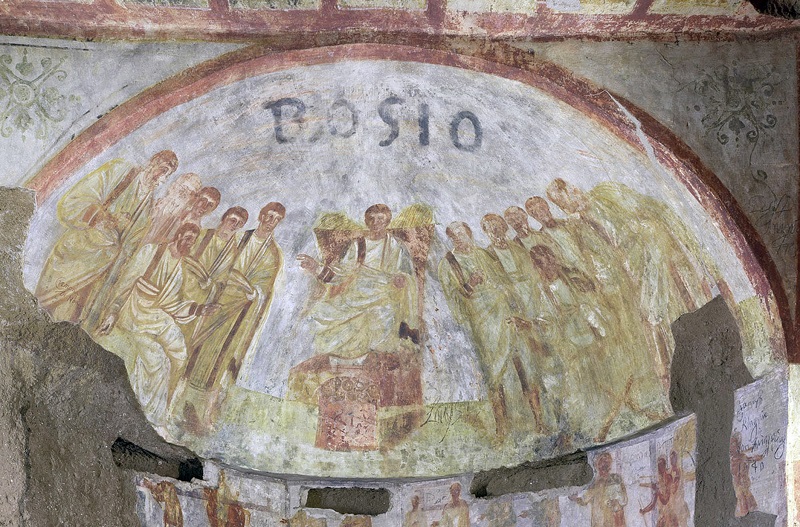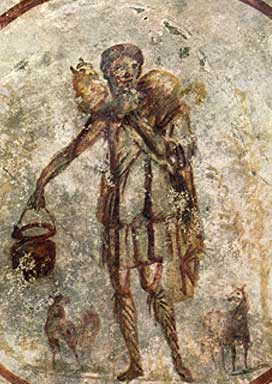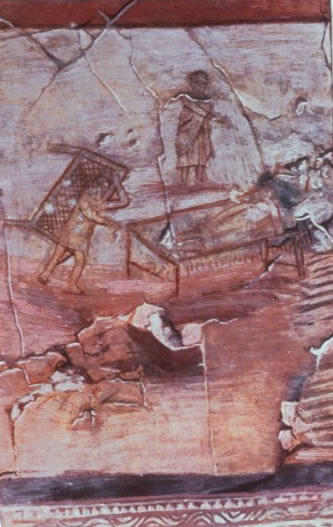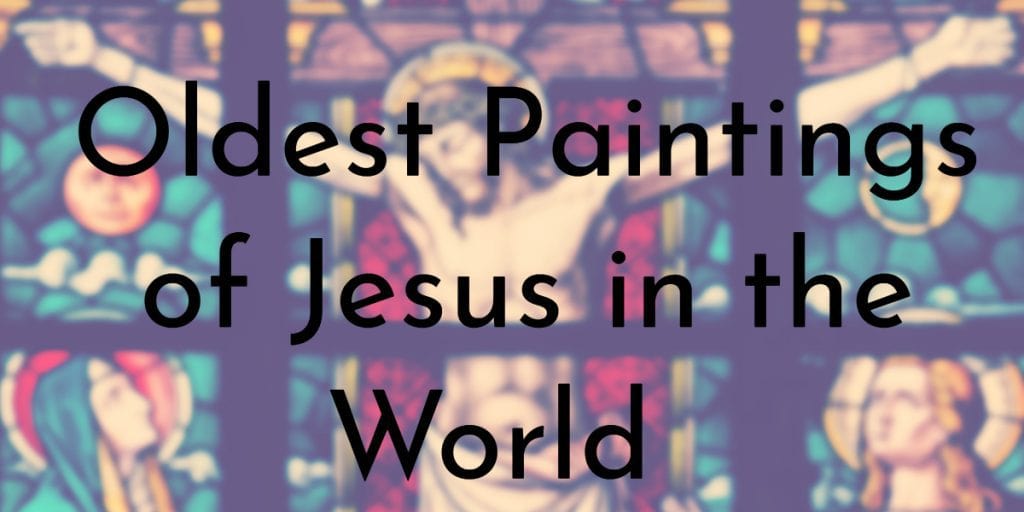Images of Jesus are common throughout Christian churches and several of these paintings are over 1,000 years old. In the early days of Christianity, Jesus was often represented by symbols such as Ichthys (fish), the peacock, or an anchor. The oldest existing paintings of Jesus as a person date back to around the late 2nd to 4th century and are primarily found in Roman catacombs.
These early paintings were simple and often showed Jesus performing good deeds.
7. Good Shepherd Mosaic
Year Painted: c.425
Location: Mausoleum of Galla Placidia, Ravenna, Italy
Image Depicted: Christ as the Good Shepherd among a flock of sheep
Materials Used: Mosaic – pieces of stone or glass

The Good Shepherd mosaic in the Mausoleum of Galla Placidia is not only one of the oldest depictions of Jesus, but one of the most beautiful and well-preserved. The Mausoleum is a UNESCO World Heritage Site and features other mosaic works of art. The Good Shepherd is found over the north entrance and shows Jesus in a more regal form than other early good shepherd paintings.
Instead of carrying a lamb on his shoulder, Jesus is sitting among his flock and is wearing gold and purple robes. The mosaic is an excellent example of the transition from showing Jesus as a simple man to depicting Him as a King of Heaven.
6. Jesus and His Apostles
Year Painted: c. early 5th century
Location: Catacombs of St. Domitilla, Rome, Italy
Image Depicted: Christ on a throne among two groups of apostles before two deceased individuals
Materials Used: Paint on plaster

The frescoes found in the catacombs of St. Domitilla were recently uncovered with a new technique called laser cleaning, which uses lasers to remove centuries of dirt and grime. One of the frescoes found in the catacombs show Christ on a throne between two groups of apostles admitting two deceased individuals into the Kingdom of Heaven.
According to Barbara Mazzei, an archaeologist with the Pontifical Commission for Sacred Archaeology, the image depicted in the fresco was rare for the time period. Some of the other frescoes show scenes from the Old and New Testament.
The religious frescoes of the catacombs were found in an “introductio,” which shows a “a personal presentation of the dead to Christ.” The newly revealed frescoes were unveiled to the public at the end of May 2017.
5. The Mosaic of St. Pudenziana
Year Painted: c.410 – 417
Location: Santa Pudenziana, Rome, Italy
Image Depicted: Christ sitting on a jewel encrusted throne surrounded by His apostles
Materials Used: Paint on plaster; gold leaf

The mosaic of St. Pudenziana is thought to be the oldest apse mosaic of its kind. Additionally, the church of St. Pudenziana is considered the most ancient of all the churches in Rome. The mosaic was created sometime between 410 and 417, during the pontification of Pope Innocent I.
In the painting, Christ is shown as a human figure wearing a golden toga with purple trim, sitting on a jewel encrusted throne, which are all signs of Roman imperial authority.
This regal depiction of Jesus permeated other Byzantine era mosaics. The mosaic was heavily restored in the 16th century and parts of it were changed or removed.
During the restoration, two of the apostles were removed as well as the whole lower part of the mosaic.
4. Christ Between Peter and Paul
Year Painted: c.4th century
Location: Catacombs of Marcellinus and Peter, Rome, Italy
Image Depicted: Christ sitting with Paul on his right and Peter on his left
Materials Used: Paint on plaster

This painting depicting Christ between Peter and Paul dates back to 4th century and is found in the Catacombs of Marcellinus and Peter. There are also several other old paintings of Christ in the catacombs.
The image in the painting show Jesus sitting with his disciples Peter and Paul on either side of Him. Below them are the four martyrs — Gorgonius, Peter, Marcellinus, and Tiburtius — separated into pairs with the Divine Lamb on the mountain between them.
This painting was one of the first to show Jesus as older and bearded, which was how He was often depicted in Christian art of the late 4th century.
In 2016, the restoration of several of the frescoes in the Catacombs of Marcellinus and Peter was finished.
3. Adoration of the Magi
Year Painted:: c. mid-3rd century
Location: Catacomb of Priscilla, Rome, Italy
Image Depicted: The three Magi bringing their gifts to Jesus after his birth
Materials Used: Paint on plaster

The fresco from the Catacomb of Priscilla in Rome is believed to be the oldest depiction of the three Magi. It dates back to around the mid-third century and appears on an arch in the catacombs.
The image is simply drawn and shows three identically sized men, in similar outfits, each carrying a gift to present to the child sitting in his mother’s lap.
The “Adoration of the Magi” was one of the most commonly depicted images from Jesus’ birth in early Christian art. These early images were typically found on catacomb walls and sarcophagus reliefs.
2. The Good Shepherd
Year Painted: c. mid-3rd century
Location: Catacombs of St. Callixtus, Rome, Italy
Image Depicted: Young, beardless Jesus carrying a lamb
Materials Used: Paint on plaster

“The Good Shepherd” is believed to be one of the oldest existing paintings of Jesus. The painting shows a young beardless Jesus collecting sheep, which was one of the most common images of Jesus at the time. This particular painting is one of the best preserved and was found in the Catacombs of San Callisto.
These catacombs are some of the oldest in Rome and is best known for its art as well as the Cypt of the Popes. Other 3rd century paintings found in the catacombs depict scenes from Christ’s life such as the Baptism of Christ and the Raising of Lazarus.
1. The Healing of the Paralytic
Year Painted: c.235
Location: Dura-Europos, Syria
Image Depicted: Christ healing a paralytic, who then gets up and walks away
Materials Used: Paint on plaster

“The Healing of the Paralytic” is believed to be the oldest painting of Jesus in the world that still exists and is a clear depiction of Christ. The painting is found on a wall in the Dura-Europos church in Syria, which is believed to be one of the oldest surviving Christian churches in the world.
This painting was discovered sometime in 1921 and dates back to around 235 AD.
The image shows Jesus Christ healing a bed-ridden man, who then has the strength to carry his bed on his back and walk.
Today, the painting is kept at the Yale University Gallery of Fine Arts as part of the Dura Europos collection with other frescoes that were found at the church.
OTHER POSTS YOU MAY BE INTERESTED IN











